 W
WThe aperture is an opening in certain kinds of mollusc shells: it is the main opening of the shell, where the head-foot part of the body of the animal emerges for locomotion, feeding, etc.
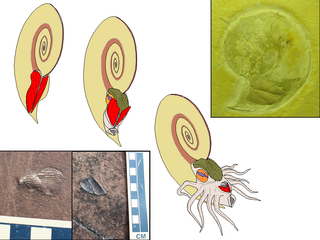 W
WAn aptychus is a type of marine fossil. It is a hard anatomical structure, a sort of curved shelly plate, now understood to be part of the body of an ammonite. Paired aptychi have, on rare occasions, been found at or within the aperture of ammonite shells. The aptychus was usually composed of calcite, whereas the ammonite shell was aragonite.
 W
WBranchial hearts are myogenic accessory pumps found in coleoid cephalopods that supplement the action of the main, systemic heart. Each consists of a single chamber and they are always paired, being located at the base of the gills. They pump blood through the gills via the afferent branchial veins. Since they only circulate venous blood, branchial hearts function under predominantly anaerobic conditions. Branchial hearts also appear to be involved in hemocyanin synthesis.
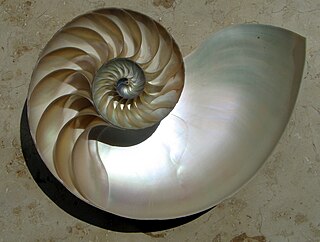 W
WCamerae are the spaces or chambers enclosed between two adjacent septa in the phragmocone of a nautiloid or ammonoid cephalopod. These can be seen in cross-sections of a nautilus shell and in the polished cross-sections of ammonites. In life these chambers are filled with gas, mediated by the siphuncle, and used to control buoyancy.
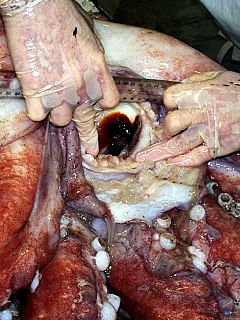 W
WAll extant cephalopods have a two-part beak, or rostrum, situated in the buccal mass and surrounded by the muscular head appendages. The dorsal (upper) mandible fits into the ventral (lower) mandible and together they function in a scissor-like fashion. The beak may also be referred to as the mandibles or jaws.
 W
WCephalopods exhibit various dermal structures on their mantles and other parts. These may take the form of conspicuous warts, cushions, papillae or scales, though in many species they are microscopic tubercles. The most elaborate forms are found among the oceanic squid of the order Teuthida.
 W
WCephalopods, as active marine predators, possess sensory organs specialized for use in aquatic conditions. They have a camera-type eye which consists of an iris, a circular lens, vitreous cavity, pigment cells, and photoreceptor cells that translate light from the light-sensitive retina into nerve signals which travel along the optic nerve to the brain. For the past 140 years, the camera-type cephalopod eye has been compared with the vertebrate eye as an example of convergent evolution, where both types of organisms have independently evolved the camera-eye trait and both share similar functionality. Contention exists on whether this is truly convergent evolution or parallel evolution. Unlike the vertebrate camera eye, the cephalopods' form as invaginations of the body surface, and consequently the cornea lays over top of the eye as opposed being a structural part of the eye. Unlike the vertebrate eye, a cephalopod eye is focused through movement, much like the lens of a camera or telescope, rather than changing shape as the lens in the human eye does. The eye is approximately spherical, as is the lens, which is fully internal.
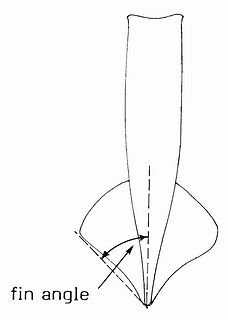 W
WCephalopod fins, sometimes known as wings, are paired flap-like locomotory appendages. They are found in ten-limbed cephalopods as well as in the eight-limbed cirrate octopuses and vampire squid. Many extinct cephalopod groups also possessed fins. Nautiluses and the more familiar incirrate octopuses lack swimming fins. An extreme development of the cephalopod fin is seen in the bigfin squid of the family Magnapinnidae.
 W
WAll cephalopods possess flexible limbs extending from their heads and surrounding their beaks. These appendages, which function as muscular hydrostats, have been variously termed arms, legs or tentacles.
 W
WChromatophores are pigment-containing and light-reflecting cells, or groups of cells, found in a wide range of animals including amphibians, fish, reptiles, crustaceans and cephalopods. Mammals and birds, in contrast, have a class of cells called melanocytes for coloration.
 W
WCirrate octopuses possess a well-developed internal shell that supports their muscular swimming fins. This is in contrast to the more familiar, finless, incirrate octopuses, in which the shell remnant is either present as a pair of stylets or absent altogether.
 W
WA ctenidium is a respiratory organ or gill which is found in many mollusks. This structure exists in bivalves, cephalopods, Polyplacophorans (chitons), and in aquatic gastropods such as freshwater snail and marine snails. Some aquatic gastropods possess one ctenidium known as monopectinate and others have a pair of ctenidia known as bipectinate.
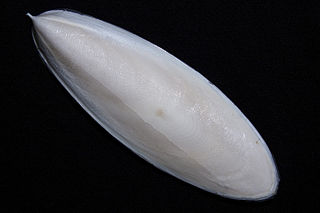 W
WCuttlebone, also known as cuttlefish bone, is a hard, brittle internal structure found in all members of the family Sepiidae, commonly known as cuttlefish, within the cephalopods. In other cephalopod families it is called a gladius.
 W
WThe dactylus is the tip region of the tentacular club of cephalopods and of the leg of some crustaceans. In cephalopods, the dactylus is narrow and often characterized by the asymmetrical placement of suckers and the absence of a dorsal protective membrane. In crustaceans, the dactylus is the seventh and terminal segment of their thoracic appendages. In certain instances the dactylus, together with the propodus, form the claw.
 W
WThe funnel–mantle locking apparatus is a structure found in many cephalopods that connects the mantle and hyponome (funnel) and restricts their movement relative to each other. It consists of two interlocking components: one located on the mantle and the other on the funnel. The apparatus may permit some anterior–posterior displacement or prevent movement altogether.
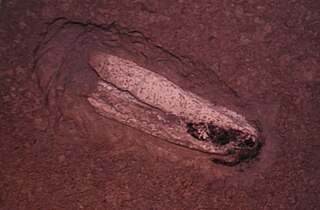 W
WThe gladius, or pen, is a hard internal bodypart found in many cephalopods of the superorder Decapodiformes and in a single extant member of the Octopodiformes, the vampire squid. It is so named for its superficial resemblance to the Roman short sword of the same name, and is a vestige of the ancestral mollusc shell, which was external. The gladius is located dorsally within the mantle and usually extends for its entire length. Composed primarily of chitin, it lies within the shell sac, which is responsible for its secretion.
 W
WA hectocotylus is one of the arms of male cephalopods that is specialized to store and transfer spermatophores to the female. Structurally, hectocotyli are muscular hydrostats. Depending on the species, the male may use it merely as a conduit to the female, or he may wrench it off and present it to the female.
 W
WAn ink sac is an anatomical feature that is found in many cephalopod mollusks used to produce the defensive cephalopod ink. With the exception of nocturnal and very deep water cephalopods, all Coleoidea which dwell in light conditions have an ink sac, which can be used to expel a cloud of dark ink in order to confuse predators.
 W
WThe mantle is a significant part of the anatomy of molluscs: it is the dorsal body wall which covers the visceral mass and usually protrudes in the form of flaps well beyond the visceral mass itself.
 W
WThe manus is the zoological term for the distal portion of the fore limb of an animal. In tetrapods, it is the part of the pentadactyl limb that includes the metacarpals and digits (phalanges). During evolution, it has taken many forms and served a variety of functions. It can be represented by the hand of primates, the lower front limb of hoofed animals or the fore paw and is represented in the wing of birds, bats and prehistoric flying reptiles (pterosaurs), the flipper of marine mammals and the 'paddle' of extinct marine reptiles, such as plesiosaurs and ichthyosaurs.
 W
WThe mollusc shell is typically a calcareous exoskeleton which encloses, supports and protects the soft parts of an animal in the phylum Mollusca, which includes snails, clams, tusk shells, and several other classes. Not all shelled molluscs live in the sea; many live on the land and in freshwater.
 W
WNidamental glands are internal organs found in some elasmobranchs and certain molluscs, including cephalopods and gastropods.
 W
WThe nuchal organ is a ciliated pit or groove present at the posterior end of the prostomium of annelid worms, some cephalopods, and other invertebrates.
 W
WThe odontophore is part of the feeding mechanism in molluscs. It is the cartilage which underlies and supports the radula, a ribbon of teeth. The radula is found in every class of molluscs except for the bivalves.
 W
WAn orthocone is an unusually long straight shell of a nautiloid cephalopod. During the 18th and 19th centuries, all shells of this type were named Orthoceras, creating a wastebasket taxon, but it is now known that many groups of nautiloids developed or retained this type of shell.
 W
WParalarvae are young cephalopods in the planktonic stages between hatchling and subadult. This stage differs from the larval stage of animals that undergo true metamorphosis. Paralarvae have been observed only in members of the orders Octopoda and Teuthida.
 W
WA photophore is a glandular organ that appears as luminous spots on various marine animals, including fish and cephalopods. The organ can be simple, or as complex as the human eye; equipped with lenses, shutters, color filters and reflectors. The bioluminescence can variously be produced from compounds during the digestion of prey, from specialized mitochondrial cells in the organism, called photocytes, or, similarly, associated with symbiotic bacteria in the organism that are cultured.
 W
WThe phragmocone is the chambered portion of the shell of a cephalopod. It is divided by septa into camerae.
 W
WSepta are thin walls or partitions between the internal chambers (camerae) of the shell of a cephalopod, namely nautiloids or ammonoids.
 W
WA siphon is an anatomical structure which is part of the body of aquatic molluscs in three classes: Gastropoda, Bivalvia and Cephalopoda.
 W
WThe siphuncle is a strand of tissue passing longitudinally through the shell of a cephalopod mollusk. Only cephalopods with chambered shells have siphuncles, such as the extinct ammonites and belemnites, and the living nautiluses, cuttlefish, and Spirula. In the case of the cuttlefish, the siphuncle is indistinct and connects all the small chambers of that animal's highly modified shell; in the other cephalopods it is thread-like and passes through small openings in the walls dividing the chambers.
 W
WIn the field of zoology, a spadix is a secondary sexual organ found in some cephalopods and hydrozoans. In the genus Nautilus, the spadix is a composite erectile organ in the male located in the oral region which is composed of four highly modified tentacles and which is paired with a somewhat smaller antispadix that is also composed of four tentacles. The spadix is normally a concealed organ but quickly becomes distended upon the animal's death. The exact function of the spadix and antispadix in Nautilus is not yet known.
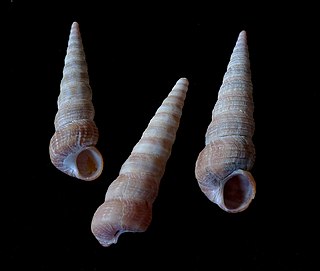 W
WA spire is a part of the coiled shell of molluscs. The spire consists of all of the whorls except for the body whorl. Each spire whorl represents a rotation of 360°. A spire is part of the shell of a snail, a gastropod mollusc, a gastropod shell, and also the whorls of the shell in ammonites, which are fossil shelled cephalopods.
 W
WThe squid giant axon is the very large axon that controls part of the water jet propulsion system in squid. It was first described by L. W. Williams in 1909, but this discovery was forgotten until English zoologist and neurophysiologist J. Z. Young demonstrated the axon's function in the 1930s while working in the Stazione Zoologica in Naples, the Marine Biological Association in Plymouth and the Marine Biological Laboratory in Woods Hole. Squids use this system primarily for making brief but very fast movements through the water.
 W
WThe umbilicus of a shell is the axially aligned, hollow cone-shaped space within the whorls of a coiled mollusc shell. The term umbilicus is often used in descriptions of gastropod shells, i.e. it is a feature present on the ventral side of many snail shells, including some species of sea snails, land snails, and freshwater snails.